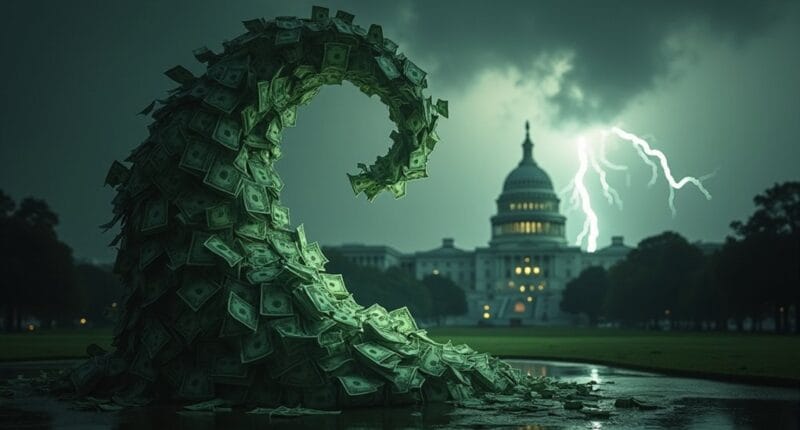America’s fiscal situation is spiraling out of control, with a staggering $1.1 trillion deficit projected by April 2025. Monthly deficits keep ballooning – May alone hit $316 billion. Politicians? They’re too busy pointing fingers to fix anything. Rising interest payments, bloated mandatory programs, and plummeting corporate tax collections paint a grim picture. Meanwhile, Washington treats this mathematical disaster like yesterday’s news. The deeper you dig into these numbers, the scarier it gets.

As America’s budget deficit continues its relentless climb, reaching a staggering $1.1 trillion by April 2025, the nation’s fiscal health has become increasingly precarious. The numbers tell a sobering story – federal spending has ballooned to $4.85 trillion while revenue growth limps along at a mere 2% increase from the previous year.
It’s like watching a train wreck in slow motion, and nobody’s pulling the emergency brake.
The usual suspects are driving this fiscal fiasco. Social Security, Medicare, and Veterans Affairs keep demanding bigger slices of the federal pie. In May alone, these mandatory programs gobbled up an additional $25 billion compared to the previous year. These programs fall under mandatory spending categories that Congress has less direct control over. Corporate tax collections dropped by a concerning $35 billion decline in the first four months of the fiscal year.
Meanwhile, FEMA’s disaster relief spending shot up 50% in February, because apparently Mother Nature didn’t get the memo about budget constraints.
Natural disasters don’t care about fiscal planning, leaving FEMA’s February budget gasping for air with a 50% spending surge.
Here’s where it gets really interesting – or terrifying, depending on your perspective. Interest payments on the national debt jumped by $7 billion in just one month. That’s right, we’re paying more and more just to service our existing debt.
It’s like using one credit card to pay off another, except this credit card has eleven zeroes on it.
The monthly deficit dance continues its awkward shuffle, with various payment timing shifts making the numbers bounce around like a ping-pong ball. May 2025’s deficit hit $316 billion – slightly better than the previous year, but that’s like celebrating because your sinking ship is taking on water slightly slower than before.
Washington’s response to this fiscal nightmare? Crickets. While mandatory spending programs expand, tax revenues struggle to keep pace, and interest payments snowball, politicians seem more interested in pointing fingers than finding solutions.
The structural deficit keeps growing faster than the economy, creating a mathematical certainty that would make even an optimistic accountant break out in a cold sweat. Yet somehow, this looming crisis remains on the back burner, simmering away while everyone pretends not to smell the smoke.





